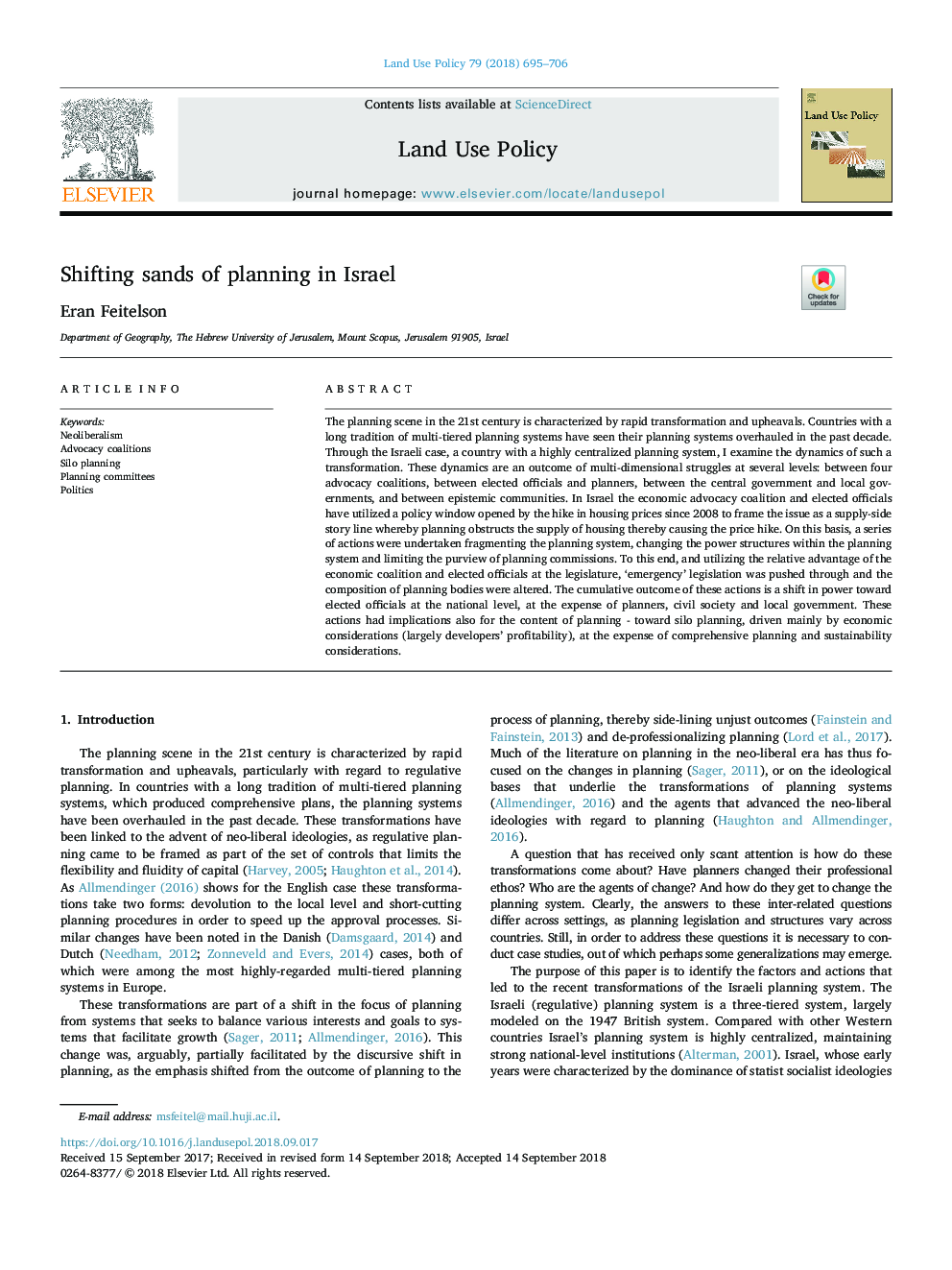| کد مقاله | کد نشریه | سال انتشار | مقاله انگلیسی | نسخه تمام متن |
|---|---|---|---|---|
| 11000106 | 1421804 | 2018 | 12 صفحه PDF | دانلود رایگان |
عنوان انگلیسی مقاله ISI
Shifting sands of planning in Israel
ترجمه فارسی عنوان
شیارهای گشت و گذار در برنامه ریزی در اسرائیل
دانلود مقاله + سفارش ترجمه
دانلود مقاله ISI انگلیسی
رایگان برای ایرانیان
کلمات کلیدی
نئولیبرالیسم، ائتلاف طرفداران، برنامه ریزی سیلو، کمیته های برنامه ریزی، سیاست،
ترجمه چکیده
صحنه برنامه ریزی در قرن بیست و یکم با تغییرات سریع و تحولات مشخص شده است. کشورهای با سنت طولانی از سیستم های برنامه ریزی چندسطحی، سیستم های برنامه ریزی خود را در دهه گذشته تجدید نظر کرده اند. از طریق پرونده اسرائیل، یک کشور با یک سیستم برنامه ریزی بسیار متمرکز، من تحولات چنین تحولاتی را بررسی می کنم. این پویایی نتیجه نتیجه مبارزات چند بعدی در سطوح مختلف است: بین چهار ائتلاف طرفدار، بین مقامات و برنامه ریزان منتخب، بین دولت مرکزی و دولت های محلی و بین جوامع معرفت شناختی. در اسرائیل، ائتلاف طرفداران اقتصادی و مقامات منتخب از یک پنجره سیاستی باز شده از سوی افزایش قیمت مسکن از سال 2008 تا کنون به منظور پیش بینی موضوع به عنوان یک خط داستان ارائه شده است که به موجب آن برنامه ریزی مانع عرضه مسکن شده و در نتیجه افزایش قیمت ها را از بین می برد. بر این اساس، مجموعه ای از اقدامات تقسیم بندی سیستم برنامه ریزی، تغییر ساختارهای قدرت در داخل سیستم برنامه ریزی و محدود کردن مجوز کمیسیون های برنامه ریزی انجام شد. برای این منظور، با استفاده از مزیت نسبی ائتلاف اقتصادی و مقامات منتخب در مجلس قانونگذاری، قوانین «اضطراری» تحت فشار قرار گرفتند و ترکیب ساختار برنامه ریزی شده تغییر یافت. نتیجه تجمعی این اقدامات تغییر در قدرت به مقامات منتخب در سطح ملی، به هزینه برنامه ریزان، جامعه مدنی و دولت محلی است. این اقدامات نیز برای محتوای برنامه ریزی - به سمت برنامه ریزی سیال، که عمدتا به لحاظ اقتصادی (به طور عمده سودآوری توسعه دهندگان)، به هزینه برنامه ریزی جامع و ملاحظات پایداری منجر می شود، پی برده است.
موضوعات مرتبط
علوم زیستی و بیوفناوری
علوم کشاورزی و بیولوژیک
جنگلداری
چکیده انگلیسی
The planning scene in the 21st century is characterized by rapid transformation and upheavals. Countries with a long tradition of multi-tiered planning systems have seen their planning systems overhauled in the past decade. Through the Israeli case, a country with a highly centralized planning system, I examine the dynamics of such a transformation. These dynamics are an outcome of multi-dimensional struggles at several levels: between four advocacy coalitions, between elected officials and planners, between the central government and local governments, and between epistemic communities. In Israel the economic advocacy coalition and elected officials have utilized a policy window opened by the hike in housing prices since 2008 to frame the issue as a supply-side story line whereby planning obstructs the supply of housing thereby causing the price hike. On this basis, a series of actions were undertaken fragmenting the planning system, changing the power structures within the planning system and limiting the purview of planning commissions. To this end, and utilizing the relative advantage of the economic coalition and elected officials at the legislature, 'emergency' legislation was pushed through and the composition of planning bodies were altered. The cumulative outcome of these actions is a shift in power toward elected officials at the national level, at the expense of planners, civil society and local government. These actions had implications also for the content of planning - toward silo planning, driven mainly by economic considerations (largely developers' profitability), at the expense of comprehensive planning and sustainability considerations.
ناشر
Database: Elsevier - ScienceDirect (ساینس دایرکت)
Journal: Land Use Policy - Volume 79, December 2018, Pages 695-706
Journal: Land Use Policy - Volume 79, December 2018, Pages 695-706
نویسندگان
Eran Feitelson,
